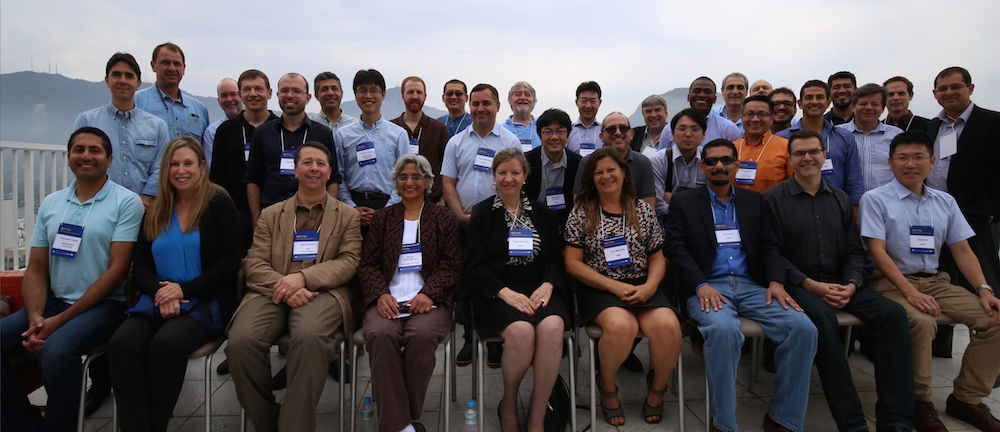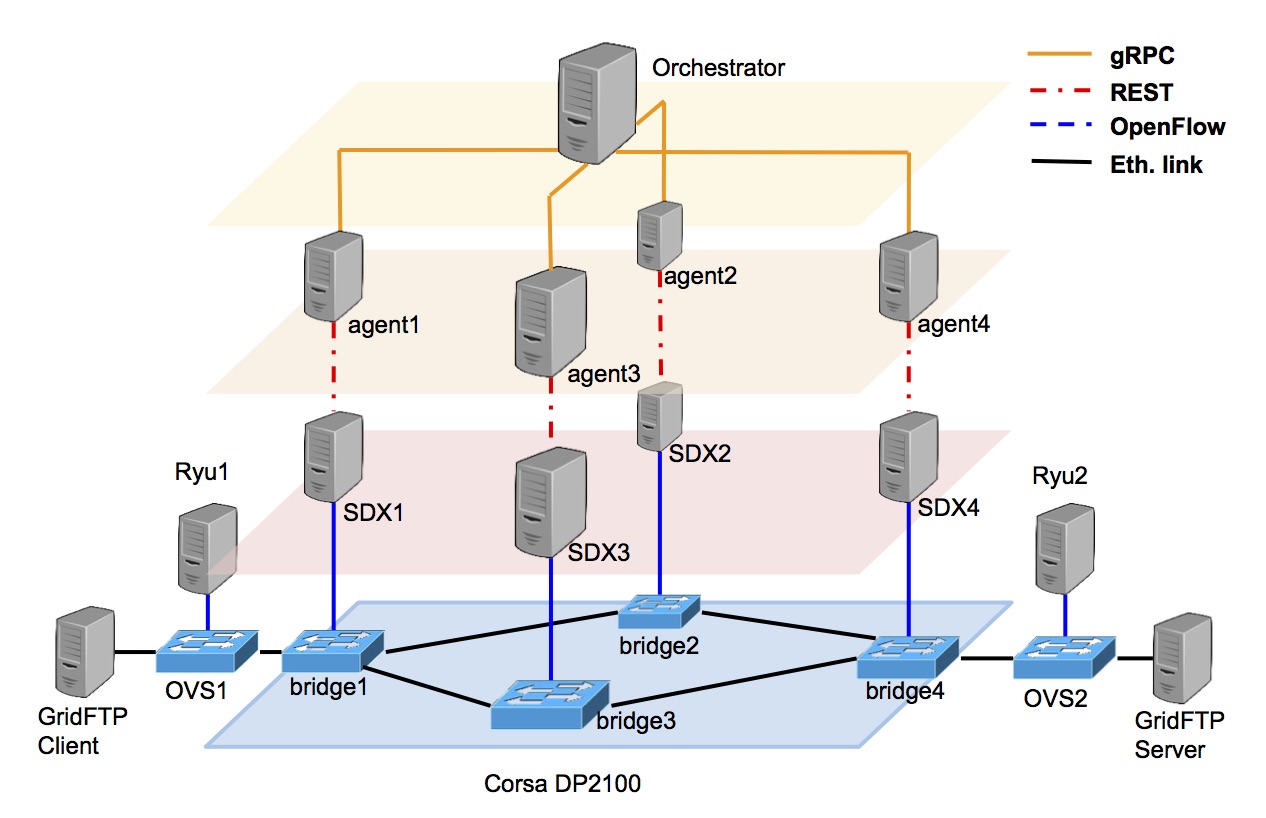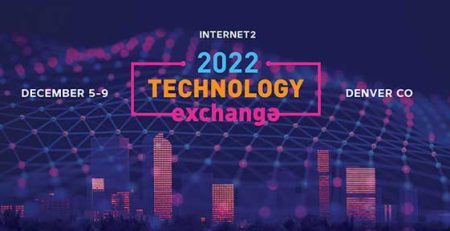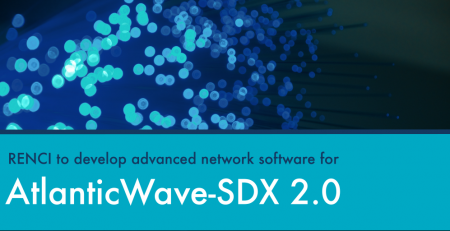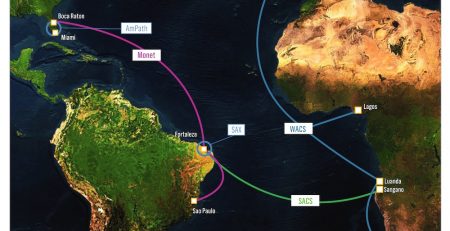AtlanticWave-SDX: A Distributed Intercontinental Experimental Software Defined

Miami, Florida, October 16, 2020 – Florida International University’s Center for Internet Augmented Research and Assessment (CIARA), in the Division of IT, is pleased to announce a new $6.5M five-year award from the U.S. National Science Foundation (NSF), Award# OAC-2029278, for the AtlanticWave-SDX: A Distributed Intercontinental Experimental Software Defined Exchange.
Open Exchange Points (OXPs) serve as meet points for connecting and facilitating the exchange of data between Research and Education (R&E) networks. They are critical cyberinfrastructure in the interconnectivity of data over long geographical distances, switching data flows from one R&E network to the next, to its destination. They require this unique effort in networking science to perform efficiently and effectively. For example, data from the Vera Rubin Observatory in northern Chile will transit six OXPs as it moves from the Southern to Northern Hemispheres. Operationalizing the transit of data flows across OXPs is increasingly important to minimize the impact from events on network services (hardware failures and soft failures). End-to-end network paths for these data flows are not under the control of any individual organization. Multiple R&E network operators collaborate and must coordinate to establish geographically distributed end-to-end paths – an effort that can take days to weeks.
Led by FIU, with the University of Southern California – Information Sciences Institute (USC-ISI), and the Renaissance Computing Institute (RENCI) at the University of North Carolina at Chapel Hill this award takes off from the previous five-year project work. AtlanticWave-SDX supports research, experimental deployments, prototyping and interoperability testing, on national and international scales.
Prof. Sérgio Novaes, Scientific Director of the Center for Scientific Computing at the Sao Paulo State University (UNESP) said, “The AtlanticWave-SDX will use several science drivers as use cases that I lead for UNESP including the Open Science Grid (OSG), the High Energy Physics Information Exchange (HEPiX) and the Advanced Institute for Artificial Intelligence (AI2). AI is playing a very important role in HEP and there are, of course, several possible intersections with other areas. UNESP has been an active partner in previous IRNC proposals led by FIU and the annual Super Computing Network Research Experiments and is an enthusiastic collaborator on the AtlanticWave-SDX advancements.”
Challenges in the Wide-Area Networks (WAN) are being addressed by the application of network virtualization and network programmability solutions using Software-Defined Networking (SDN) and Network Functions Virtualization (NFV) technologies. Network virtualization and programmable networks are two key enablers that facilitate agile, fast and more economical network infrastructures as well as service development, deployment and provisioning. This award for the AtlanticWave-SDX project will introduce new capabilities, enabling OXPs to react to unplanned network events by adding intelligent closed-loop control of network services powered by in-band network telemetry.
“We are excited to work with CIARA at FIU on this important next step towards establishing networks as a provisioned resource” said Frank Wuerthwein, Open Science Grid Executive Director.
“Pegasus bridges scientific domains and the execution environment by automatically mapping high-level workflow descriptions onto distributed resources. Pegasus has been used in a number of scientific domains including astronomy, bioinformatics, earthquake science, gravitational wave physics, ocean science, limnology, and others. We look forward to collaborating with the AtlanticWave-SDX team to enhance resource sharing and improve the movement of data with minimal latency,” said Ewa Deelman Research Director, Science Automation Technologies, USC Information Sciences Institute.
AtlanticWave-SDX is comprised of two network science initiatives: An infrastructure development component with optical super channels to reframe and reprovision network capacity between R&E backbone networks; and, an innovation component to develop a distributed intercontinental experimental SDX by leveraging OXPs in the U.S., Chile, Brazil, and S. Africa.
“The Atlantic-Wave-SDX project broadens the scope and usage of the leading-edge terabit-scale Software Defined Networking solutions NoviFlow has delivered in partnership with FIU. We are truly gratified to see our efforts with FIU contribute not only to the advancement of networking science, but also in real-world applications benefiting leading academic researchers around the world,” said Dominique Jodoin, NoviFlow’s President and CEO.
About FIU: Florida International University is an urban, multi-campus, public research university serving its students and the diverse population of South Florida. FIU is committed to high-quality teaching, state-of-the-art research and creative activity, and collaborative engagement with its local and global communities. Fostering a greater international understanding, FIU is a major international education center with a primary emphasis on creating greater mutual understanding among the Americas and throughout the world. FIU is Miami’s first and only public research university, offering bachelor’s, master’s, and doctoral degrees. Designated as a top-tier research institution, FIU emphasizes research as a major component in the university’s mission (http://www.fiu.edu).
About RENCI: The Renaissance Computing Institute (RENCI) develops and deploys advanced technologies to enable research discoveries and practical innovations. RENCI partners with researchers, government, and industry to engage and solve the problems that affect North Carolina, our nation, and the world. An institute of the University of North Carolina at Chapel Hill, RENCI was launched in 2004 as a collaboration involving UNC Chapel Hill, Duke University, and North Carolina State University (www.renci.org)
About USC/ISI: The USC Information Sciences Institute (ISI) is a component of the University of Southern California (USC) Viterbi School of Engineering, and specializes in research and development in information processing, computing, and communications technologies. ISI is a world leader in research and development of advanced information processing, computer and communications technologies. ISI work ranges from theoretical basic research, such as core engineering and computer science discovery, to applied research and development, such as design and modeling of innovative prototypes and devices. (www.isi.edu). The Pegasus project, based at ISI, encompasses a set of technologies that help workflow-based applications execute in a number of different environments including desktops, campus clusters, grids, and clouds. Pegasus bridges the scientific domain and the execution environment by automatically mapping high-level workflow descriptions onto distributed resources. https://pegasus.isi.edu/about/
About AMPATH: Florida International University’s Center for Internet Augmented Research and Assessment (CIARA), in the Division of IT, has developed an international, high-performance research connection point in Miami, Florida, called AMPATH (AMericasPATH; www.ampath.net). AMPATH extends participation to underrepresented groups in Latin America and the Caribbean, in science and engineering research and education through the use of high-performance network connections. AMPATH is home to the Americas Lightpaths Express and Protect (AmLight-ExP) high-performance network links connecting Latin America to the U.S., funded by the National Science Foundation (NSF), award #OAC-1451018; and the AtlanticWave-SDX: NSF Award# OAC- 1451024, 2015-2020, IRNC: RXP: AtlanticWave-Software Defined Exchange: A Distributed Intercontinental Experimental Software Defined Exchange (SDX) (www.ciara.fiu.edu).
About ANSP: The ANSP project (an Academic Network at São Paulo), as determined by a decision of FAPESP’s Board of Trustees, “provides the State of São Paulo research community with state-of-the-art computer networking connectivity.” ANSP develops and maintains the infrastructure, Internet services and data communication in general which, in conjunction with ANSP’s Technical Reserve Program, offers the education and research community in the State of São Paulo the technological means needed to access information throughout the world, to share knowledge, to develop collaborative projects and for innovation on a large scale. The ANSP Project is run by NARA from The Medical School of the University of São Paulo and is funded by FAPESP (www.ansp.br).
About NoviFlow: NoviFlow Inc. provides open standard-based Terabits per second performance SDN networking solutions to network operators, data center operators, enterprises and government agencies seeking greater performance, flexibility and cost-efficiency. NoviFlow has offices in Montreal, Boston, Melbourne, Singapore, Seattle and Sunnyvale, and representatives in Asia Pacific, Europe, and the Middle East. For more information, visit https://noviflow.com/. Follow NoviFlow on Twitter @NoviFlowInc.
About Open Science Grid (OSG): OSG provides common service and support for resource providers and scientific institutions using a distributed fabric of high throughput computational services. The OSG does not own resources but provides software and services to users and resource providers alike to enable the opportunistic usage and sharing of resources. The OSG is funded through a diverse portfolio of awards from the National Science Foundation and the Department of Energy https://opensciencegrid.org .
About Vera Rubin Observatory: The Vera Rubin Observatory project activities are supported through a partnership between the National Science Foundation (NSF) and the Department of Energy. NSF supports LSST through a Cooperative Agreement managed by the Association of Universities for Research in Astronomy (AURA). The Department of Energy funded effort is managed by the SLAC National Accelerator Laboratory (SLAC). Additional Vera Rubin Observatory funding comes from private donations, grants to universities, and in-kind support from Institutional Members of Vera Rubin Observatory (http://www.lsst.org/).
About RNP: The Brazilian Education and Research Network (RNP), qualified as a Social Organization (OS) by the Brazilian government, is supervised by the Ministry of Science, Technology and Innovation (MCTI), and is maintained through the Inter-Ministry RNP program, which also includes the Ministries of Education (MEC), Health (MS), Citizenship and Defense (MD). The first Internet provider in Brazil with national coverage, RNP operates a high-performance nationwide network, with points of presence in all 26 states and the national capital, providing service to over 1200 distinct locations. RNP’s more than four million users are making use of an advanced network infrastructure for communication, computation and experimentation, which contributes to the integration of the national systems of Science, Technology and Innovation, Higher Education, Health and Culture (http://www.rnp.br/en).
About RedCLARA: CLARA, the Latin American Cooperation of Advanced Networks (Cooperación Latino Americana de Redes Avanzadas), is a non profit organization whose members are the NRENs of Latin America, and which is in charge of the management, development and operation of RedCLARA as well as the coordination of Latin America’s research networking activities. RedCLARA directly connects to AmLight links in Sao Paulo, Miami and Tijuana. Latin American NRENs connected to redCLARA: Argentina (Innova-Red), Brasil (RNP), Chile (REUNA), Colombia (RENATA),Costa Rica (RedCONARE), Ecuador (CEDIA), El Salvador (RAICES), Guatemala (RAGIE), México (CUDI), Panamá (RedCYT), Perú (RAAP), Uruguay (RAU), and Venezuela (REACCIUN) (www.redclara.net).
About TENET/SANReN: The Tertiary Education and Research Network of South Africa (TENET), and South African National Research Network (SANReN) jointly form the South Africa’s NREN. SANReNis a business unit inside the South African CSIR’s National Integrated Cyberinfrastructure System (NICIS) and is responsible for the design, acquisition and roll-out of national and international capacity for the South Africa NREN, as well as the development and incubation of advanced services (https://www.sanren.ac.za/). TENET (https://www.tenet.ac.za) operates the SANReN, which is a key component of the South African government’s National Integrated Cyberinfrastructure System (NICIS), alongside the Centre for High Performance Computing (CHPC) and the Data Intensive Research Initiative of South Africa (DIRISA).
About UNESP: São Paulo State University (UNESP) is one of the largest and most important Brazilian universities, supported by State funds and along with USP (Universidade de São Paulo) and Unicamp (Universidade Estadual de Campinas). The Center for Scientific Computing (CSC) at UNESP operates a science-driven production cyberinfrastructure, providing high-performance computing resources and technical support to the University’s research community. UNESP CSC engineering team operates a Tier-2 class cluster of the Worldwide LHC Computing Grid (WLCG), owned by the Sao Paulo Research and Analysis Center (SPRACE) research group and used by high-energy physicists around the world (https://sprace.org.br/). UNESP CSC is also responsible for the GridUnesp project, one of the largest grid enabled HPC infrastructures in Latin America and an official member of the Open Science Grid (OSG) Consortium since 2005, when it became the first official OSG Virtual Organization outside the US (https://www2.unesp.br/portal#!/gridunesp). UNESP CSC is also responsible for the only official Grid Certification Authority in operation in Brazil (http://gridca.ansp.br/).



